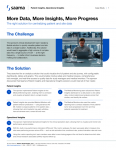Q&A
FDA ‘taking an important step’ with new clinical trial transparency pilot program

The program proposes to make the clinical study reports (CSRs) associated with the recent approvals of nine new drugs public.
Additionally, the FDA has also announced plans to provide the ClinicalTrials.gov identifier number (NCT#) to FDA materials for future drug approvals. According to the agency, the number will make it easier to associate the clinical trial listings on ClinicalTrials.gov to FDA communications about specific drugs.
After the pilot program is complete, the FDA will seek public feedback through a Federal Register notice and docket for public comments.
“The FDA is taking an important step in making additional clinical data publicly available,” said Thomas Wicks, chief strategy officer of TrialScope.
“To better serve the patient and trial participant community, it will be necessary to ensure that the CSR includes the synopsis section, and consider future initiatives to address the disclosure plain language summaries and copies of the Informed Consent forms,” he told us.
To learn more, Outsourcing-Pharma.com caught up with Wicks to further discuss the program and its implications.
What effect with the pilot program have on the industry and future clinical trials?
Assuming the pilot is successful and leads to the adoption of this practice, it will require all sponsors to prepare their CSRs for disclosure, which means redacting or anonymizing sensitive personal data and possibly some company-confidential information that may be present in the CSR.
We don’t expect this to change how future clinical trials are conducted, but we do see companies adjusting their approach to authoring protocols and CSRs to prepare these for eventual disclosure and minimize the need for redaction.
For some organizations, this may represent a significant new burden, especially as they work through the logistics of preparing, reviewing and internally approving this information for public disclosure of their first CSR.
It will help these organizations that other trial sponsors and solution providers have gained experience in Europe, where this document disclosure has been required since January 2015.
What challenges could it pose?
When trial sponsors talk about making CSRs publicly available, the main concern is the effort and process for preparing the documents for disclosure.
The challenge is that these documents were not written with disclosure in mind, and while the layout and content of future CSRs may anticipate eventual disclosure, existing documents will require a careful review to ensure that all data falling under privacy regulations have been effectively anonymized and sensitive company information redacted.
Complicating this process is that data privacy laws in Europe and the United States are not well harmonized, so CSRs that are made public in both the EU and the US may have different requirements for anonymization, de-identification, or redaction.
How is the pilot different from what is required in the EU?
Precisely which CSR sections will be made public by the FDA is not yet clear, so we will have to wait to compare the FDA approach with the EMA requirements.
One noted difference is that we have not yet seen a requirement to provide Individual Patient Data (IPD), which is a pending requirement in the EU.
How has the discussion around clinical trial transparency evolved over the past few years and how do you expect this conversation to continue?
Over the past few years, the question from industry sponsors has not been “why is disclosure necessary?” – But, “how can we comply with the requirements efficiently, and how can we provide data disclosure that is more meaningful?”
The trend is a greater emphasis on communicating valuable information to patients, trial participants, and the larger research community, as well as providing a wider scope of trial data voluntarily.
There are still many opportunities to improve the scope, clarity, consistency, and usability of the disclosed data, but it is clear that the value of clinical data transparency is being recognized by a growing number of sponsors and the public at large.



















